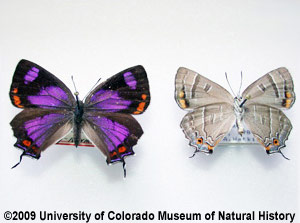OBJECT OF THE MONTH - JULY 2009
Colorado Hairstreak Butterfly (Hypaurotis crysalus)

Male Colorado hairstreak butterfly.
The Colorado hairstreak (Hypaurotis crysalus, family Lycaenidae) is a butterfly native to Colorado and many parts of the Southwestern United States. This butterfly became Colorado's state insect in 1996, thanks in part to Melinda Terry's fourth grade class at Wheeling Elementary School in Aurora, Colorado.
The Colorado hairstreak can usually be found in areas where its host plant, Gambel's oak (Quercus gambelii, family Fagaceae), is common. The adults lay eggs singly on oak leaves or bark in late summer to early fall; the eggs then overwinter. The caterpillars emerge from the eggs in early spring and feed on the Gambel's oak leaves as they develop. The larval stages of this butterfly have never been described, which is unusual for such a well-known butterfly. There is one generation per year and adults can be found from June through August. Adult butterflies feed on tree sap, raindrops, and aphid honeydew.

Male Colorado hairstreak butterfly, dorsal (upper) side and female Colorado hairstreak, ventral (lower) side.
The Colorado hairstreak is one of North America's most beautiful butterflies. Its coloration is purple with a wide black-to-brown border containing orange spots. Like many other hairstreak species, adult Colorado hairstreaks have a "tail" emerging from the lower portion of each hind wings.
The University of Colorado Museum of Natural History's Entomology Section has some excellent specimens of the Colorado hairstreak. The specimen with the upper side showing is a male. Males are easily identified by the larger portions of orange that they have on their wings compared to the females. This specimen was collected by Donald Eff in Phillipsburg, Colorado, which is on the southwestern side of Denver. The specimen with the underside showing is a female, and this specimen was collected on Sandis Mountain in Bernallio County, New Mexico.


